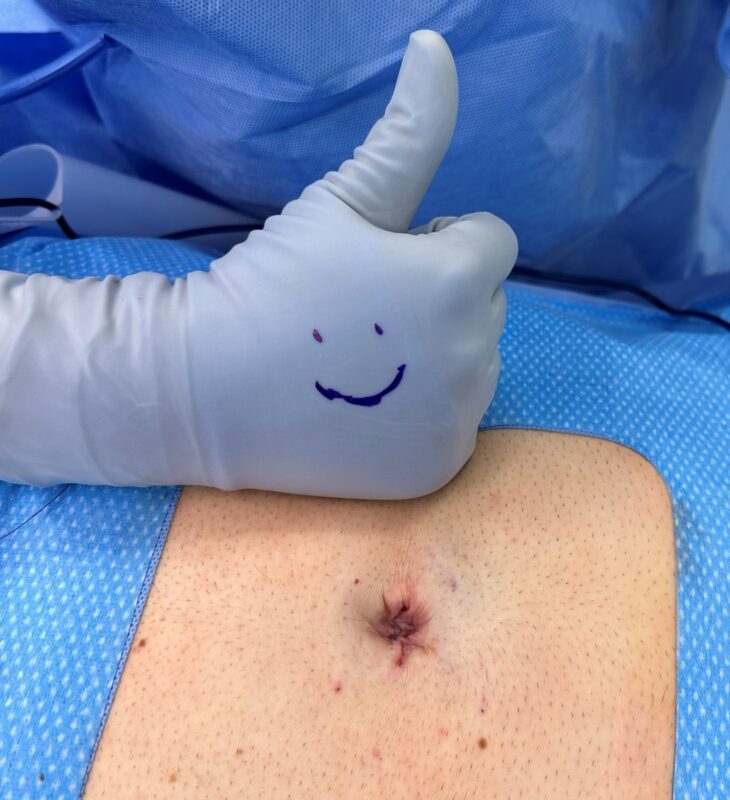Patients with small umbilical or ventral hernias (size of the defect less than 2 cm) and BMI less than 30 kg/m2 may benefit from primary hernia repair (closure of the defect with resorbable sutures and without mesh). These operations can be performed through a small incision hidden inside the navel, which leads to an esthetically pleasing scar once the healing is complete.
Older data suggests that in patients with low BMI, the recurrence rate is 14% without mesh, versus 4% with mesh repairs. However, the study included a very heterogenous group of patients, with defects up to 4 cm, which is quite large for a primary repair. Nonetheless, those patients still had 86% chance of a successful repair.
With quality data lacking, the 2020 guidelines by the American Hernia Society and European Hernia Society advise repair with mesh in all umbilical and ventral hernias to decrease the chance of recurrence, when compared with suture repair alone. However, we find the technique recommended in the article (open preperitoneal repair with mesh) to be highly variable among different surgeons and with inconsistent results. Furthermore, the above-mentioned guidelines do not address the long-term consequences of open repairs with preperitoneal mesh.
Lastly, a 2022 article found that long-term recurrence rates after tissue repair (no mesh) of small umbilical hernias (<1 cm) was only 1.8%. Thus, patients with small umbilical hernias undergoing a suture repair have a 98.2% chance of not having a recurrence.
In patients with larger defects or obesity (BMI>30) the recurrence rates can be significantly increased after a primary repair, due to the unbalanced tension exercised on the tissues by the sutures. Therefore, most authorities recommend mesh reinforcement in this category of patients. Various techniques are employed based on patient factors and hernias characteristics. The best one will be chosen at the time of the surgical consultation.
Special consideration should be given to patients who have an umbilical hernia and associated diastasis recti (separation of the rectus abdominis muscles, which forms a “crease” when sitting up from a flat position). This condition is common after pregnancy but can also be encountered in other instances. The ideal situation is correction of the diastasis recti with physical therapy exercises, and postponing the umbilical hernia repair for a few months, until the separation is resolved. However, in patients unable to completely correct the diastasis, various surgical techniques exist to achieve this surgically at the same time with the umbilical hernia repair.






Do you honor Medicare at all?
Do you know of Doctors who perform Non-Mesh, Desarda, or Shouldice hernia repair in Arizona, Iowa, or Missouri?.. (I’m 65 years old and live part-time each year in AZ, IA, and MO).
Are there any Surgeons that accept Medicaid or Humana? Near iowa
Dear doctors, I have an umberlica hernia it’s a size of a quarter it not getting bigger or smaller I noticed it this year 6 months ago I noticed it after shower I was thinking what is that I think it’s because last year and this year around January 2024 I had a terrible coughing it probably caused the weaken of the hole that caused my small intestine to bulge a little I am kind of scared because I have no insurance and I never had surgery I am in my fifties healthy don’t drink or smoke never I am little overweight my BMI is 30 i am 5 feet 10 weight at 200.
The community north in Indianapolis don’t know how many umberlica hernia they performed yearly what are my outcomes how soon can I go back to work also how Long before I can pick up heavy things can I walk soon as same day after surgery is it best to put mesh and what type of surgery should I go in the routine open or close surgery.
Thank you very much. I am scared to go to perform this umberlica hernia I don’t know what to expect. Please help. Happy holidays